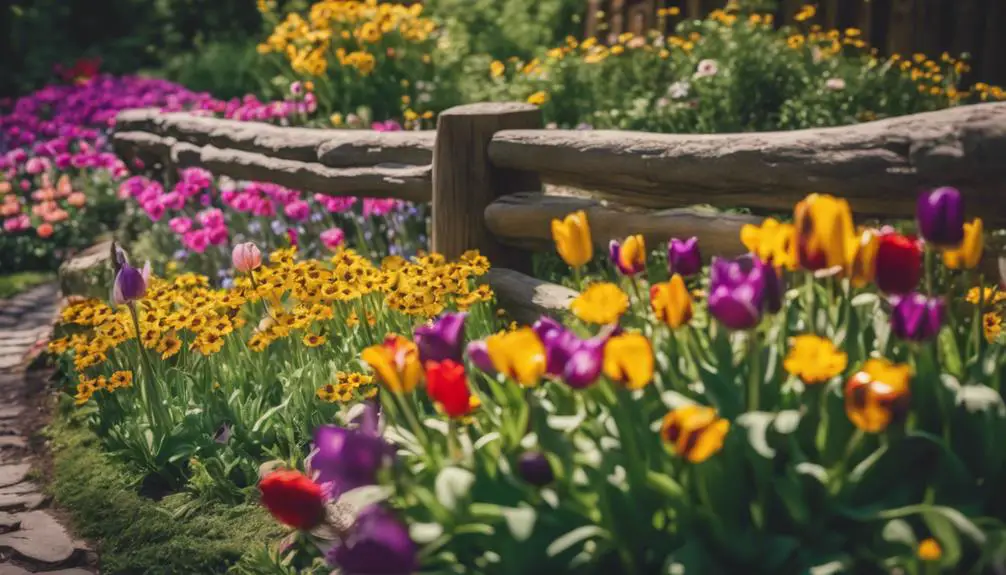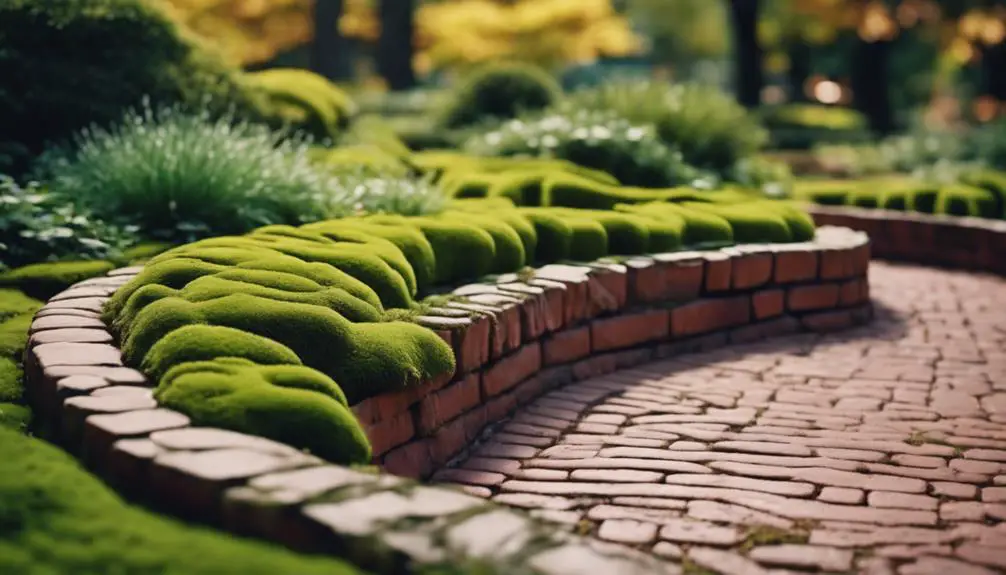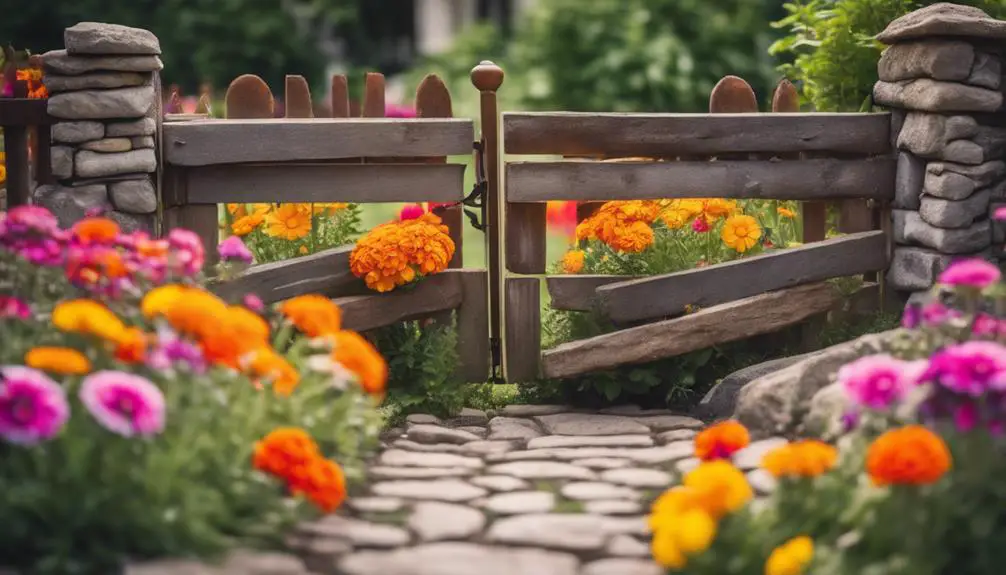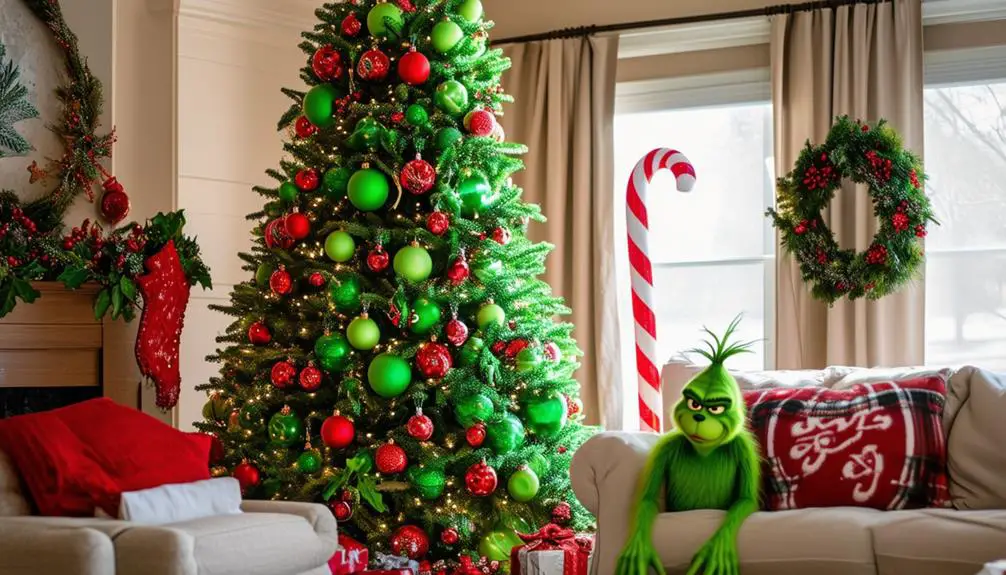As you envision your ideal front yard, a beautifully designed flower bed is likely top of mind. You're not alone in wanting to create a stunning first impression for your home. With so many styles and options to choose from, it can be overwhelming to get started. But, by considering a few key elements – like plant selection, shape, and decorative accents – you'll be well on your way to crafting a gorgeous outdoor space that reflects your personal taste. And, with a few expert tips and tricks, you can create a flower bed that's not only beautiful but also low-maintenance and functional.
Vibrant Blooms for Every Season

Plant a kaleidoscope of flowers in your front yard to create a vibrant display that changes with the seasons.
By incorporating a mix of annuals and perennials, you'll guarantee a dynamic visual experience that evolves throughout the year.
In the spring, welcome Spring Blooms like tulips, daffodils, and hyacinths, which burst forth in a riot of color.
As summer gives way to fall, Fall Florals like chrysanthemums, asters, and sedum take center stage, painting your yard with warm, autumnal hues.
To add depth and texture, consider layering flowers of varying heights and bloom times.
For example, pair low-growing, early-blooming creeping thyme with taller, later-blooming black-eyed susans.
Lush Greenery for Year-Round Interest
You'll want to incorporate evergreen tree varieties that provide structure and texture to your front yard flower bed, even in the dead of winter.
Consider winter flower colors like burgundy, gold, and bronze that add a pop of vibrancy to your landscape during the colder months.
Evergreen Tree Varieties
Surrounded by a tapestry of vibrant flowers and lush foliage, evergreen trees serve as the steadfast backbone of your front yard flower bed, providing year-round interest and structure.
When selecting evergreen tree varieties, consider factors like growth rate, mature size, and foliage color to guarantee they complement your flower bed's overall aesthetic.
For a dramatic statement, choose a specimen tree like the weeping blue atlas cedar, whose silvery-blue foliage cascades elegantly towards the ground. Alternatively, opt for a compact, slow-growing variety like the dwarf Alberta spruce, perfect for smaller spaces.
Strategic tree placement is also vital.
Position evergreen trees near the bed's edges to create a sense of depth and frame your flowers. Alternatively, place them centrally to create a striking focal point.
Consider the trees' mature canopy size and branch spread to guarantee they don't overcrowd your flowers.
Winter Flower Colors
Beyond the structure and framework provided by evergreen trees, winter flower colors bring a vital splash of vibrancy to your front yard flower bed during the coldest months.
You can create a winter wonderland by incorporating flowers with frosty hues and winter whites into your design. Cyclamen, with their delicate heart-shaped leaves and vibrant pink, white, or purple blooms, add a pop of color to your winter landscape.
Pansies, violas, and snapdragons are also great options, as they thrive in cooler temperatures and come in a range of winter-inspired colors. Consider pairing these flowers with evergreen shrubs like boxwood or holly to create a striking contrast.
To add texture and depth, incorporate ornamental grasses like blue oat grass or pampas grass, which provide movement and visual interest even in the snow. By incorporating these elements, you'll create a winter flower bed that's both beautiful and resilient.
Creative Hardscaping Ideas

As you envision your dream front yard, incorporating creative hardscaping ideas can elevate the entire aesthetic.
By combining paver patterns and stone textures, you can create a visually striking foundation for your flower beds. Consider a herringbone pattern with rectangular pavers to add depth and visual interest. Alternatively, a circular pattern with square pavers can create a sense of movement and energy.
To add texture and dimension, incorporate different stone textures into your design. Rough-hewn fieldstones can provide a natural, rustic look, while smooth bluestone can create a sleek, modern feel.
You can also mix and match different textures to create a unique, one-of-a-kind look. Don't be afraid to experiment with different patterns and textures to find the perfect combination that reflects your personal style.
Small Space Flower Bed Designs
Even the smallest of front yards can boast a stunning flower bed, thanks to clever design strategies that maximize space.
When working with a small scale, compact layouts are key to creating a beautiful and functional flower bed. Consider using a narrow, rectangular shape that hugs the perimeter of your yard, making the most of every inch.
This layout also allows for easy maintenance and pruning.
To add visual interest, incorporate vertical elements like trellises or obelisks to draw the eye upward.
Choose compact, slow-growing plants that won't overwhelm the space, such as dwarf conifers, succulents, or creeping thyme.
Don't be afraid to get creative with container placement – tucking pots into tight corners or using hanging baskets to add depth.
Remember to balance your design with a mix of textures, colors, and forms to keep the space engaging.
Colorful Cottage-Style Gardens

You envision a whimsical retreat that's bursting with colorful blooms and lush foliage – a quintessential cottage-style garden that beckons you to linger.
To create this charming oasis, start by selecting a mix of flowering perennials, shrubs, and ornamental grasses in a variety of textures and hues.
Consider combining roses, peonies, and foxgloves with boxwood, lavender, and coneflowers for a lush, layered look.
Add whimsical accents like distressed garden benches, rusty gates, and weathered planters to infuse your garden with cottage charm.
Don't be afraid to incorporate unexpected elements, such as a vintage window or a repurposed door, to create visual interest and personality.
Soften the space with meandering paths, pavers, or brick walkways that invite exploration and discovery.
To maintain the lush, overflowing feel, don't be shy about layering plants and allowing them to spill over onto paths and borders.
This will create a sense of abundance and romance, drawing you and your guests into the heart of your cottage-style garden.
Modern and Minimalist Approaches
You'll create a modern and minimalist front yard flower bed by focusing on clean lines, which can be achieved through the strategic use of rectangular planters, geometric-shaped flowers, and a limited number of statement pieces.
Simple color schemes also play a vital role in this aesthetic, as they help to create a sense of calm and visual cohesion.
Clean Lines Matter
As modern and minimalist approaches gain popularity in landscape design, clean lines emerge as a crucial element in creating a visually stunning front yard flower bed.
You'll want to incorporate clean lines to achieve a modern aesthetic that exudes sophistication and elegance. Geometric patterns are an excellent way to introduce clean lines into your design.
Consider using rectangular or square planters, or create a geometric pattern with stones or gravel to add visual interest.
When selecting plants, choose varieties with strong, architectural lines, such as succulents or ornamental grasses.
These plants will add structure and definition to your design, further emphasizing the clean lines. Avoid curved or winding paths, opting instead for straight, linear walkways that lead the eye through the garden.
Simple Color Schemes
A limited color palette is essential to a modern and minimalist front yard flower bed, where simplicity and restraint create a striking visual impact.
By restricting your color selection, you can create a cohesive look that's both calming and visually appealing.
A monochromatic harmony, where different shades of the same color are used, can add depth and interest to your flower bed without overwhelming the senses.
For a softer, more whimsical approach, consider a pastel palette.
Soothing hues like pale pink, baby blue, and mint green can evoke a sense of serenity and tranquility.
To incorporate these colors, choose flowers with delicate petals and soft, feathery foliage.
You can also add decorative elements like stones, pebbles, or shells in complementary hues to enhance the overall aesthetic.
Flower Bed Shapes and Designs

Design your flower bed shape and design to reflect your personal style and complement your home's architecture.
This is your opportunity to get creative and make a statement in your front yard.
Consider curved borders to soften the edges of your flower bed and create a natural, flowing look.
You can pair curved borders with rounded plants like hydrangeas or hostas to create a cohesive design.
For a more modern look, incorporate angular patterns into your flower bed design.
Use geometric shapes like triangles or rectangles to create a visually appealing layout.
Combine angular patterns with structural plants like succulents or ornamental kale to add depth and texture.
Don't be afraid to experiment and mix different shapes and patterns to create a unique design that reflects your personality.
Remember to balance your design with a clear focal point and visual flow to guide the viewer's eye through the flower bed.
Incorporating Ornamental Grasses
Vibrancy erupts when ornamental grasses are incorporated into your front yard flower bed, adding movement and texture to the overall design.
You can create a stunning visual effect by combining ornamental grasses with flowering plants, creating a dynamic interplay of color, shape, and texture. To achieve a grassland theme, choose ornamental grasses with varying heights, textures, and colors, and arrange them in a naturalistic, sweeping pattern.
Add whimsy accents, such as brightly colored flowers or bold foliage, to create visual interest and break up the monotony of a single-grass landscape.
When selecting ornamental grasses, consider their mature size, growth habits, and light requirements to guarantee they flourish in your front yard. Some popular varieties include pampas grass, blue oat grass, and fountain grass.
You can also experiment with different planting styles, such as massing, layering, or creating a focal point with a statement grass. By incorporating ornamental grasses into your flower bed design, you'll add depth, complexity, and visual appeal to your front yard landscape.
Water-Wise Flower Bed Options

As you face the challenge of creating a beautiful front yard flower bed while conserving precious water resources, you'll find that water-wise flower bed options offer a stylish and sustainable solution.
By incorporating drought-tolerant plants, you can reduce water consumption while maintaining a vibrant, lush appearance. Consider incorporating succulents, sedums, and yucca into your design, as these plants thrive in dry conditions.
Xeriscape design principles, which emphasize efficient irrigation and mulching, can also help minimize water waste. When selecting plants, look for species that require minimal watering, such as California poppy, lupine, and purple coneflower.
Avoid planting flowers that require frequent watering, like hydrangeas and impatiens. By adopting water-wise flower bed options, you'll not only conserve water but also reduce maintenance and create a beautiful, eco-friendly outdoor space.
Beautifully Edged Flower Beds
You're about to create a stunning visual frame for your flowers with beautifully edged flower beds.
Brick edging options offer clean lines and a classic look, while natural stone borders bring a touch of organic elegance to your front yard.
Brick Edging Options
Brick edging adds a touch of sophistication to your flower bed, defining its boundaries while creating a beautiful visual contrast with the surrounding lawn.
You can choose from various brick patterns to create a unique look that complements your flower bed's design. Consider a running bond pattern, where bricks are laid in a staggered formation, or a herringbone pattern, which features zigzagging bricks. For a more subtle look, opt for a soldier course pattern, where bricks are laid in a straight line.
When it comes to edging styles, you can choose from a variety of options.
A flush edging style, where the bricks are level with the surrounding lawn, creates a clean and modern look. A raised edging style, where the bricks are slightly higher than the surrounding lawn, adds depth and dimension to your flower bed. You can also experiment with a combination of edging styles to create a unique and visually appealing look.
With brick edging, the possibilities are endless, and you're sure to create a beautiful and sophisticated flower bed that enhances your front yard's curb appeal.
Natural Stone Borders
With natural stone borders, your flower bed's edges take on a rugged, organic beauty that harmonizes with the surrounding landscape.
This edging option adds a touch of sophistication and elegance to your outdoor space. You can choose from a variety of rock edges, such as fieldstone, bluestone, or flagstone, each with its unique texture and pattern.
To create a visually appealing design, ponder the stone patterns you want to incorporate. You can opt for a random pattern, where stones of different sizes and shapes are arranged to create a natural, effortless look.
Alternatively, you can choose a more formal pattern, such as a running bond or herringbone design, to add a touch of sophistication.
When selecting natural stone borders, make sure to weigh the color and texture of the stones in relation to your flower bed's plants and surrounding hardscapes.
Nighttime Flower Bed Lighting

As dusk falls, your beautifully manicured flower bed transforms into a mystical haven, thanks to strategic nighttime flower bed lighting.
You can create an enchanting ambiance by placing solar lights along the pathways or around the perimeter of your flower bed. These energy-efficient lights come in a variety of styles, from modern lanterns to whimsical fairy lights, and can be easily installed without any wiring.
To add an extra layer of drama, incorporate Moonlight accents, which mimic the soft, ethereal glow of the moon.
You can place these lights at the base of plants or trees to create pools of light that highlight their textures and forms. For a more subtle effect, use string lights or net lights to create a soft, diffused glow that permeates the entire flower bed.
Seasonal Flower Bed Maintenance
Dig into the world of seasonal flower bed maintenance, where timely tweaks and thoughtful planning keep your outdoor oasis looking its best year-round.
As you navigate the changing seasons, adapt your flower care tips to guarantee a thriving display of color and texture.
In the spring, prune back dead stems, fertilize, and mulch to prepare your flowers for new growth.
Summer's warmth demands regular watering, deadheading, and pest management to prevent damage.
As autumn arrives, tidy up spent blooms, and divide or transplant perennials as needed.
Finally, winterize your bed by cutting back stems, adding a layer of compost, and protecting sensitive plants from harsh weather.
Effective seasonal planning involves tracking your flowers' specific needs and scheduling tasks accordingly.
Create a calendar to stay on top of tasks, and make adjustments as needed based on your region's climate and weather patterns.
Frequently Asked Questions
Can I Plant Flowers in My Front Yard if It's Heavily Shaded?
You can still plant flowers in your heavily shaded yard, but choose shade-tolerant varieties that thrive under a dense canopy. Consider astilbe, bleeding heart, or impatiens, which will flourish despite limited sunlight, adding vibrant color to your shaded oasis.
How Often Should I Water My Flower Bed During Hot Summer Months?
During hot summer months, you'll want to water your flower bed deeply but infrequently to encourage deep root growth. Check the soil's moisture levels with a moisture meter, and water only when it reaches 20-30% dryness, usually every 7-10 days, to avoid overwatering and root rot.
Are There Any Flowers That Can Thrive in Poor Soil Conditions?
You'll be thrilled to know that certain flowers can flourish in poor soil conditions with the right tweaks! Try incorporating soil amendments like compost or manure, and explore fertilizer options like fish emulsion or bone meal to give your blooms a boost.
Can I Use Mulch to Suppress Weeds in My Flower Bed?
You can effectively suppress weeds by applying a 2-3 inch layer of organic mulch, like wood chips or bark, and maintaining it by replenishing as needed, ensuring a weed-free zone that's both functional and visually appealing.
Do I Need to Deadhead Flowers to Encourage More Blooming?
You're wondering if deadheading flowers boosts blooming cycles. Yes, removing spent blooms prolongs flower longevity, as energy is redirected to producing new flowers instead of seed production, resulting in more vibrant, repeat performances throughout the growing season.
Conclusion
With these front yard flower bed ideas, you'll be well on your way to creating a stunning outdoor space that's both beautiful and functional. By combining vibrant blooms, lush greenery, and creative hardscaping elements, you'll add visual interest and curb appeal to your home. Remember to choose compact plants, incorporate vertical elements, and add decorative touches to make the most of your space. With a little planning and creativity, your front yard flower bed will be the envy of the neighborhood.




